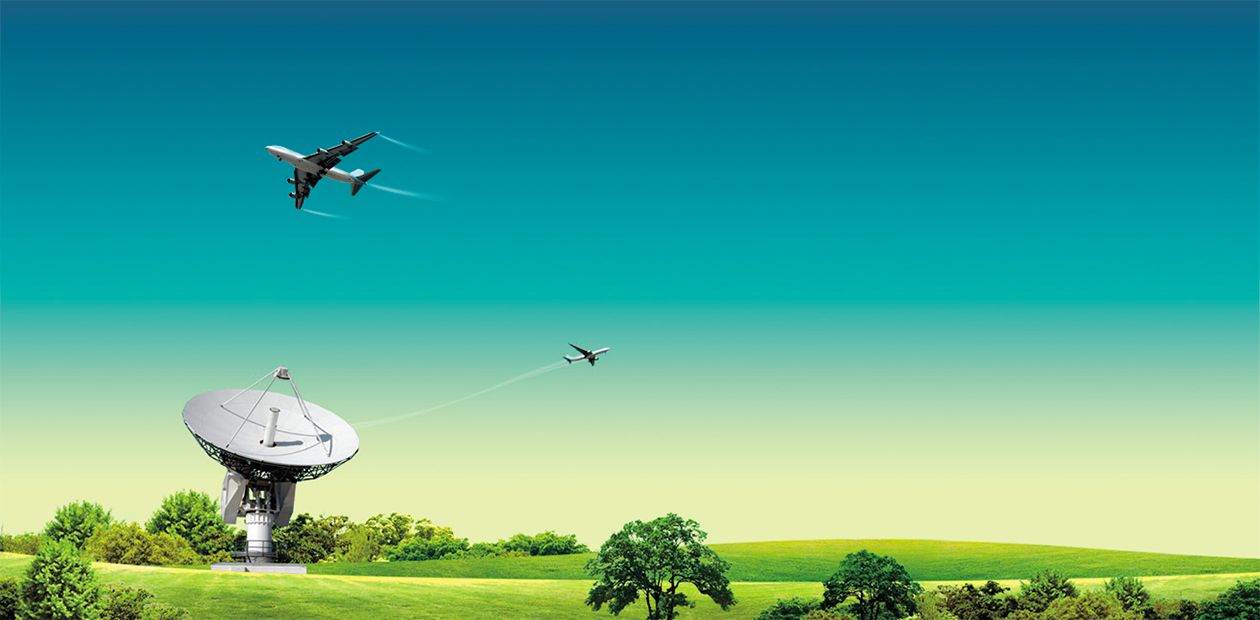"Space Weather" Forecast
The development of the incoherent scatter radar in Irkutsk, which is the only radar of incoherent scattering of radio waves in Russia, is one of the best large-scale examples of conversion of military equipment to a powerful set of tools designed exclusively for peaceful purposes: scientific research in the field of solar-terrestrial physics. Using such advanced radar facilities, one can study the entire set of complicated problems of interaction of the Earth atmosphere, magnetic field, and solar wind to provide a “space weather” forecast needed in many fields of human activities from radio communications and satellite navigation to electric power supply for on-ground facilities
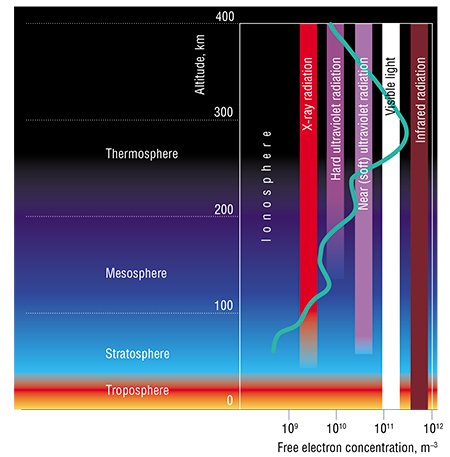 The assumption of existence of an electroconducting layer (later called the ionosphere) in the upper part of the Earth atmosphere was put forward simultaneously by several scientists at the end of the 19th century. The hypothesis allowed them to explain regular variations of the magnetic field of the Earth, though the academic community was rather skeptical about this idea.
The assumption of existence of an electroconducting layer (later called the ionosphere) in the upper part of the Earth atmosphere was put forward simultaneously by several scientists at the end of the 19th century. The hypothesis allowed them to explain regular variations of the magnetic field of the Earth, though the academic community was rather skeptical about this idea.
It was only the era of radio that made it possible to settle this question. It turned out that the only possible explanation for the effect of superfar propagation of electromagnetic waves of the decameter range (high frequency radio waves) is the existence of an ionized gas (plasma) layer reflecting radio waves above the Earth surface. This property of the ionosphere, which is extremely important for practice and which made it possible to transmit radio signals to very large distances, stimulated many researchers in various countries to start intense experimental and theoretical investigations of the ionosphere structure and processes proceeding there.
Based on the accumulated knowledge about the ionosphere, a new research direction has been formed in the last decades: solar-terrestrial physics, which deals, among other things, with transformations of various forms of solar radiation during interaction with matter and fields in the near-Earth space.
Frontier world
The physics of the Earth ionosphere is very complicated. This is an open system: fluxes of energy and matter enter this system from above (from the Sun and solar wind) and from below (from the dense and turbulent lower atmosphere).
Horizontal winds blow in the ionosphere, giant waves travel to and fro, electric fields are generated, and complicated chemical reactions take place. Sometimes it is as difficult to predict the ionosphere behavior as to make a correct weather forecast. It is not accidental that the international scientific community uses the term “space weather” to describe the entire set of phenomena in the upper atmosphere of the Earth.
Ionosphere is the upper (above 50 km) layers of the Earth atmosphere, which are characterized by the ionized state of matter (plasma). Owing to the presence of charged particles (ions and free electrons), the ionosphere possesses electrical conductivity, and therefore can reflect electromagnetic waves of the radio-frequency range. It is “short” (10—100 m) radio waves that are predominantly reflected, so they can propagate outside the line-of-sight limits, i. e. there exists a phenomenon of superfar radio communications.Ionization of gas molecules results from solar radiation in the range from X-ray frequency to soft ultraviolet radiation. The degree of ionization directly depends on solar activity
Meanwhile, accurate prediction of the behavior of the ionospheric plasma is an urgent task! Its state affects the quality of radio communications, flight dynamics of low-orbit space vehicles, accuracy and reliability of operation of navigation satellite systems, and operation of on-ground power engineering infrastructure (especially at high latitudes). being reflected off a conducting medium was used to study the ionosphere by methods of radio location. Complete reflection occurs if the wave frequency coincides with the natural plasma frequency of the ionized medium, which is uniquely determined by the volume concentration of free electrons.
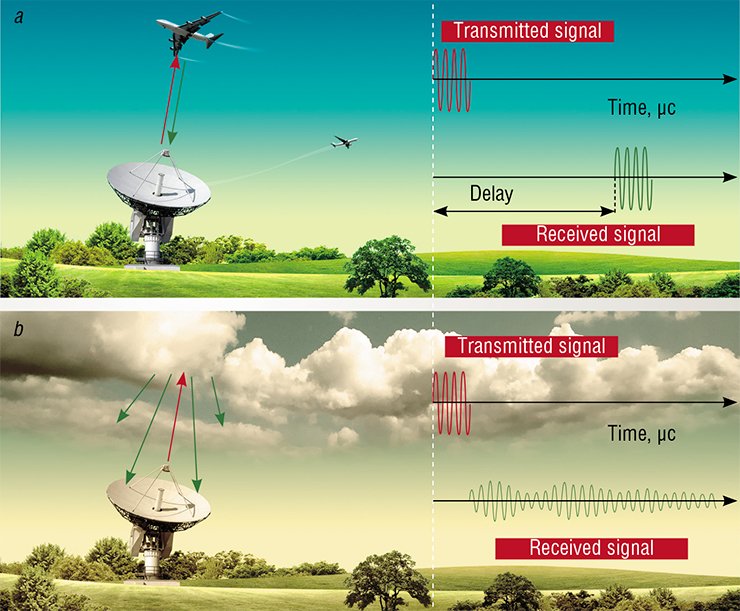
Initially, ionosphere research was performed by facilities of vertical probing whose operation principle is based on measuring the time of propagation of short-wave signals to the reflecting ionosphere layer and back. Using the ionogram, i.e., the plot of the returning signal delay as a function of the probing frequency, researchers determined a rather limited set of parameters, in particular, the distribution of the electron concentration over the altitude.
At moderate latitudes, this value rarely exceeds 1013 m-3; therefore, only waves with the frequency below 20 MHz (i.e., with the length of 15 m and more) have a chance to be reflected in the case of vertical probing. However, as these waves do not penetrate above the main peak of ionization (about 300 km) because they are completely reflected off the lower layer, this method is inapplicable for studying the upper layers of the ionosphere.
Messengers of higher spheres
The development of the new method of remote investigation of ionospheric plasma was stimulated by rapid development of radio electronics and, in particular, radio location techniques during WWII and in postwar times.
In spring 1958, Professor of the Cornell University (USA) W. Gordon shared his ideas with young researchers at a workshop. The fact is that the medium in which radio waves with frequencies above the critical frequency of the ionospheric plasma exist is almost transparent; therefore, the lion’s share of energy goes to space. Only weak signals scattered in the backward direction reach the Earth, but these information signals come from all ionospheric altitudes, including those above the main peak of ionization; and they can be recorded.
A radar (radio locator) is a device for scanning the space in order to detect foreign objects and measure the distance to these objects and their relative velocity. The operation principle of this device consisting of a transmitter and receiver is based on reflection of radio waves off obstaclesAccording to Gordon’s calculations, the most powerful radars that existed at that time were capable of detecting the weak signals of electromagnetic wave scattering on thermal fluctuations of electron concentration. This assumption made it possible to study the entire thickness of the ionosphere; it is no wonder that researchers became enthusiastic.
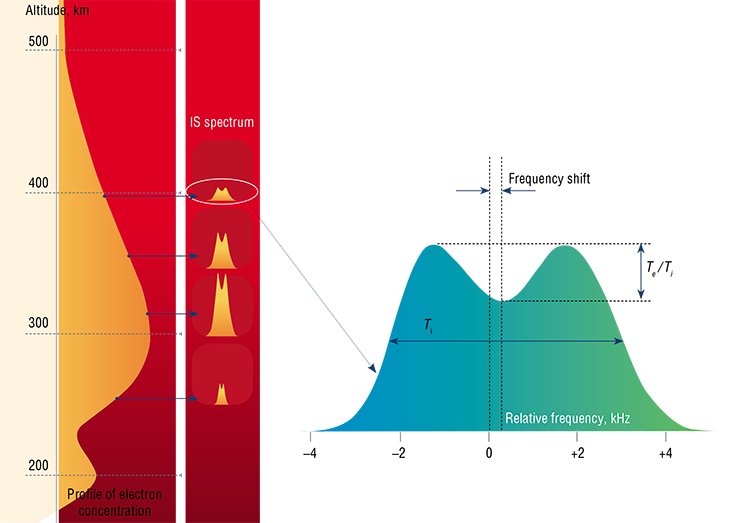
Only half a year later, the young American physicist K. Bowles obtained the first spectra of signals of the so-called incoherent scattering (IS) on a large 41-MHz radar in Illinois. The shape of these spectra came as a surprise. Gordon had expected that scattering would occur on the free electrons of ionospheric plasma, hence the scattered signal spectrum had to be consistent with the Maxwellian distribution of electrons in terms of thermal velocities. However, the width of the experimentally obtained spectra corresponded to thermal velocities of ions rather than electrons, and all spectra had a specific shape with two humps, rather different from the Maxwellian distribution.
Anyway, there appeared a powerful research tool indispensable at the early stage of intense conquering of space. A new era began in physics of the ionosphere and upper atmosphere: the era of incoherent scatter radars.
Experimental and theoretical fundamentals of the new method developed simultaneously. In the 1960s, IS radars were constructed in Central, South, and North America, and also in Europe. The theory of incoherent scattering was also improved: the IS spectral parameters were correlated with plasma properties: chemical composition, temperature of ions and electrons, drift velocity, etc.
At the moment, the ionosphere diagnostics is based on the radio location equation, which relates the averaged spectrum of the received signal to the spectrum of thermal fluctuations of ionospheric plasma.
Powerful and sensitive
Many characteristics of IS radars are appreciably different from those of conventional radar stations.
The usual radar deals with reflected signals, which are fairly exact copies of transmitted signals. The main task of this radar is to measure the delay of signal propagation and, based on this delay, to determine the distance to the target. The IS radar deals with a distributed object: thermal fluctuations of the plasma with random phases. The signal scattered on this object looks dissimilar to the transmitted signal, and its power is extremely low. The entire tremendous volume of the plasma (about 104 km3) which is instantaneously, by a millisecond pulse, “illuminated” in the space sector irradiated by the radar is equivalent to a one-ruble coin in terms of its reflectivity. Therefore, the energy potential is extremely important for the IS radar signal: these facilities transmit megawatts and receive picowatts.
All IS radars are characterized by a large antenna surface area and an extremely high sensitivity of the receiver. The biggest radar located in Arecibo (Puerto Rico) has an antenna 300 m in diameter, and the foundation of this radar is an extinct volcano crater!
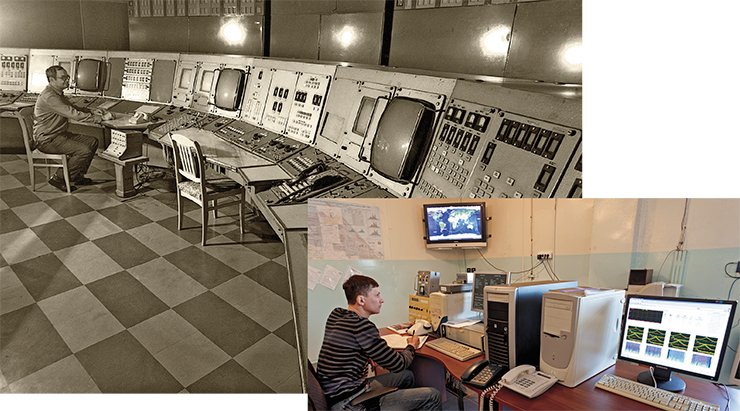
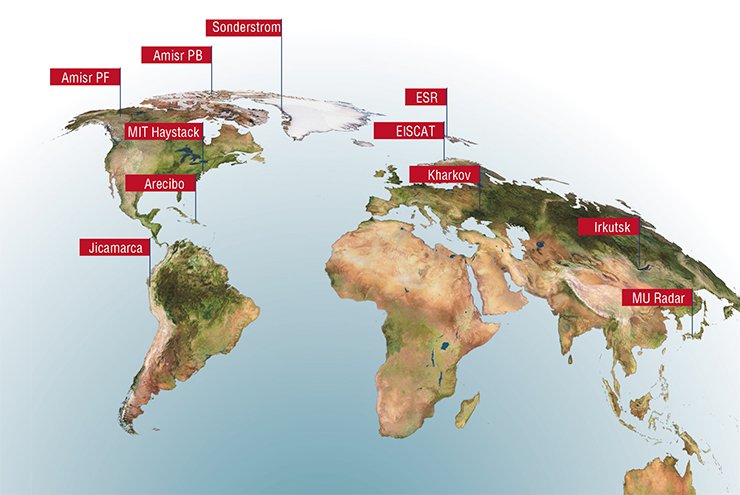
Incoherent scatter radars are perfect tools to study the vertical transfer of energy and matter in the “atmosphere-ionosphere-magnetosphere” system and the horizontal redistribution of energy over the planet. Now there are eleven facilities of this kind in the world, each being unique in terms of its structure and methods of signal processing. The results of observations of the worldwide radar network are collected and generalized in international databases (for instance, Madrigal, which is supported by the Haystack observatory in the USA).
The worldwide community is now developing a global project which envisages a meridional circle of IS radars around the globe. For this purpose, it is planned to supplement the already available network with similar facilities in South-East Asia, Latin America, and even Antarctica. This arrangement of radars will allow simultaneous round-the-clock observations over the entire globe, aimed at solving global scientific problems.
The first IS radar was created in Russia in the 1970s by a team of researchers from Kharkov Polytechnical Institute, headed by Professor V. I.Taran. Now it is used as a research and trial facility by the Institute of Ionosphere of the Academy of Sciences and Ministry of Education of Ukraine.
Pacified Dnepr
In Siberia, ionospheric research by the method of incoherent scattering dates back to the 1980s. Based on the initiative of Doctor of Physics and Mathematics A. N. Zherebtsov, then the director of the Irkutsk Institute of Solar-Terrestrial Physics, the researchers used the equipment of the Dnepr military radio location stations included into the system of warning about the missile attack. It was with the use of those facilities that the first spectra of incoherent scattering signals were obtained and observations during the solar eclipse were performed. Operating the military facilities allowed the research workers to gain necessary experience in maintaining the complicated equipment and in processing the information obtained.
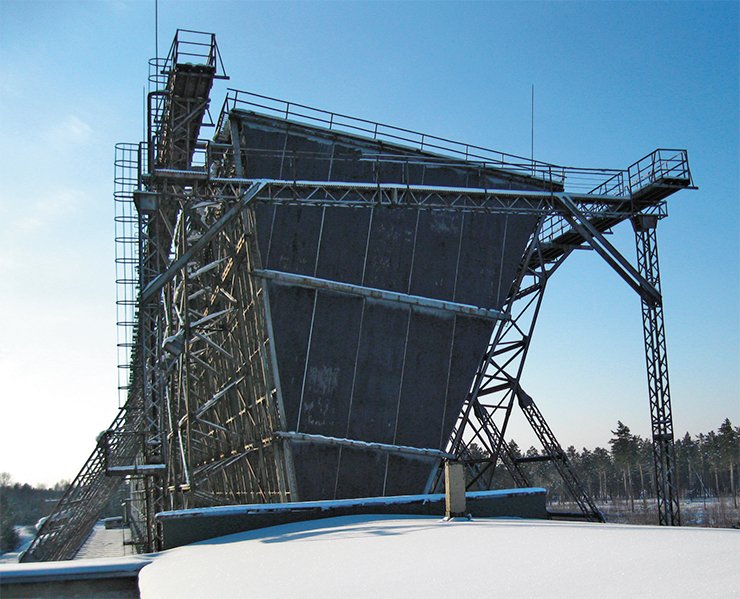
Nevertheless, the researchers needed their own, “peaceful”, radar. Therefore, when one station was discarded from service in 1993, it was re-equipped for research purposes. It was an extremely difficult task at the time when any attempt to create a large-scale test facility seemed to be a risky venture. But the researchers could not wait for better times: the station would have been just sold for scrap.
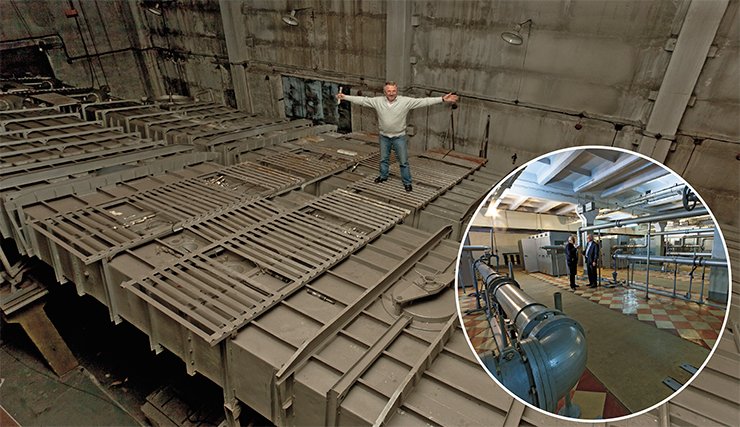
The team of “adventurers” consisting of young physicists and radio engineers was headed by the Candidate of Physics and Mathematics A. P. Potekhin (now he is a Corresponding Member of the Russian Academy of Sciences and Director of the Institute of Solar-Terrestrial Physics SB RAS). Seeing the researchers’ enthusiasm and understanding the complexity of problems, many people tried to help, including Academician V.A. Koptyug, SB RAS Chairman, Colonel General V. M. Smirnov, Commander of the Rocket-Space Defense Troops, and V. E. Ordanovich, Designer-in-Chief of the Dnepr station. The retired officers who had worked at Dnepr for many years undertook to restore and maintain the radio electronic and engineering equipment on the station.
Finally, the IS radar came into being. Later a few well-known specialists said that the transfer of the radar station to the ISTP SB RAS was the only example of effective conversion of complicated and expensive military equipment in the post-Soviet era.
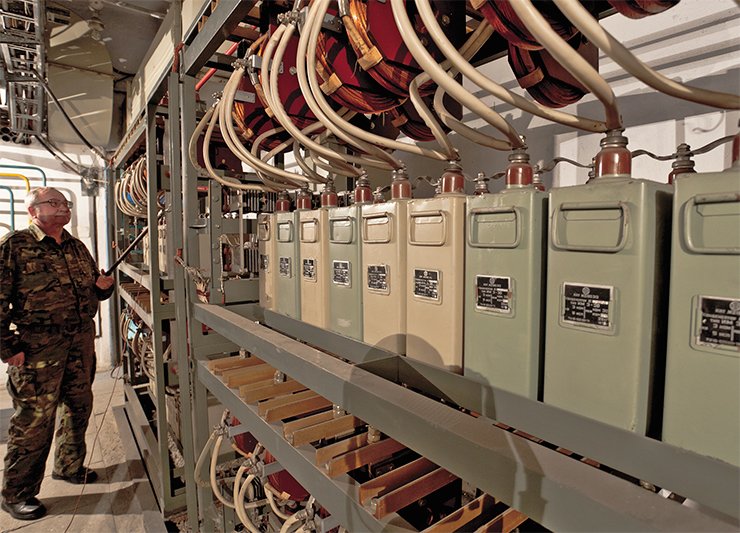
Before becoming an IS radar, the former guard of the space boundaries of the USSR was subjected to several stages of intense upgrading. The changes were made in all controlling, receiving, and recording devices, and in tools for signal processing. These systems were reconstructed on the basis of modern digital fast-response devices, which allowed the researchers to put the radar potential and the specific features of the structure of its antenna to good use.
Today the Irkutsk IS radar (IISR) is a multi-purpose research system with an extremely wide range of tasks. Regular long-term observations of ionospheric plasma are performed here in order to discover the laws of seasonal variations and the influence of the levels of solar and geomagnetic activity, as well as specific atmospheric events (e.g., winter warming in the stratosphere), and other factors. This IS radar, the only one in Russia, is an important part of the worldwide radar network, closing the worldwide “chain” of medium-latitude radars in the USA, Europe, and Japan.
Space monitoring
Because of the fixed orientation of the antenna and availability of the polarization filter, the Irkutsk radar can transmit and receive only one linear polarization of the electromagnetic field.
This “drawback,” however, allows researchers to obtain valuable information owing to the Faraday effect. When the radio wave passes through ionospheric plasma, the plane of its polarization rotates around the wave propagation line, the rotation angle being proportional to the integral electron density along the wave path. As a result, there appear “fading” periods in the altitude profile of the scattered signal power at those altitudes from which the wave suppressed by the polarization filter arrives. Based on measuring the “fading” phase, the IISR provides the absolute values of electron concentration without using external means of calibration, which are necessary for other IS radars.
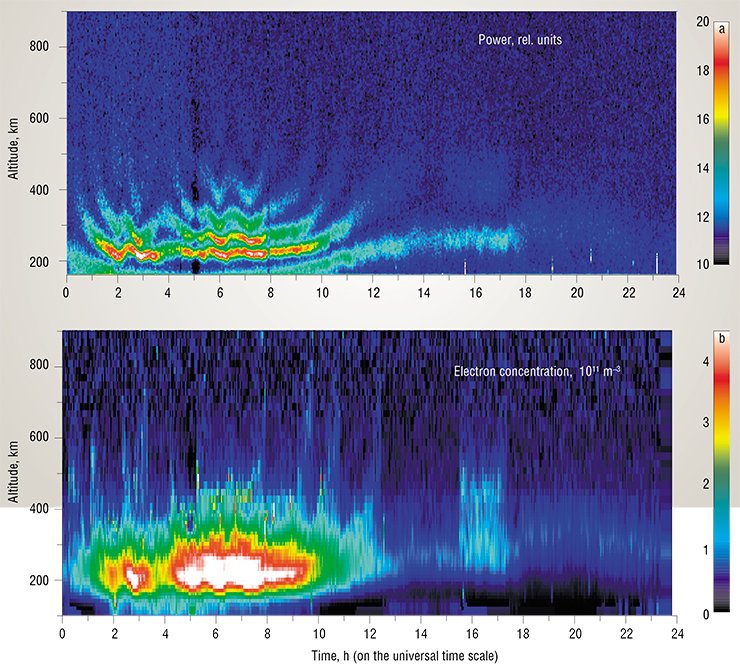
Another useful specific feature of the Irkutsk radar is its ability to change instantaneously the radiation direction. This is extremely important for studying the spatial gradient of plasma characteristics, in particular the altitude-time structure and specific features of propagation of wave perturbations of density in the ionosphere.
Moreover, the former radio location station Dnepr, even after being transformed to a radar, was still able to detect compact objects at altitudes from 15 to 6000 km. The signal reflected off satellites are much more powerful than ionospheric scattering signals; accordingly, when the plasma parameters are determined, one satellite accidentally encountered by the radar beam can appreciably distort the data about the medium.
Therefore, each radio location scanning in the IISR is automatically examined for containing reflections from compact space objects. If the scanning contains such a signal, it is analyzed with a different algorithm: the amplitude of the reflected signal, angular coordinates, distance to the target, and its beam velocity are measured.
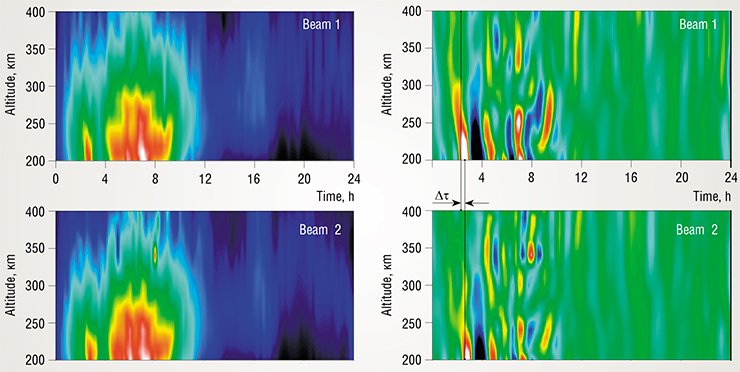
Today almost 10 % of the “pictures” taken by the radar exhibit the effect of artificial objects distorting the overall pattern. Thus, studying the ionosphere, the radar simultaneously studies the orbital distribution of active space vehicles and space debris. The problem of space contamination is extremely urgent at the moment: the number of registered fragments bigger than 10 cm in size reaches dozens of thousands. The mean distance between space objects in low (less than 1000 km) orbits is 450 km.
The high concentration of fragments not only creates problems in studying the ionosphere signals, but also is dangerous for active satellites. This “orbital junkyard” can be controlled only by a sufficiently dense network of observation stations with high-accuracy measurements. IS radars contribute to this work.
The radar can solve other interesting research problems. One example is studying the effects arising in the ionosphere during the operation of space vehicle engines on the orbital flight segment. The work has been carried out by ISTP SB RAS since 2007, in collaboration with the Rocket-Space Corporation Energia and the Central Research Institute of Machine Building (Korolev). This was the objective of the Plasma-Progress test series aimed at studying the effect of transport space vehicles on the near-Earth plasma.
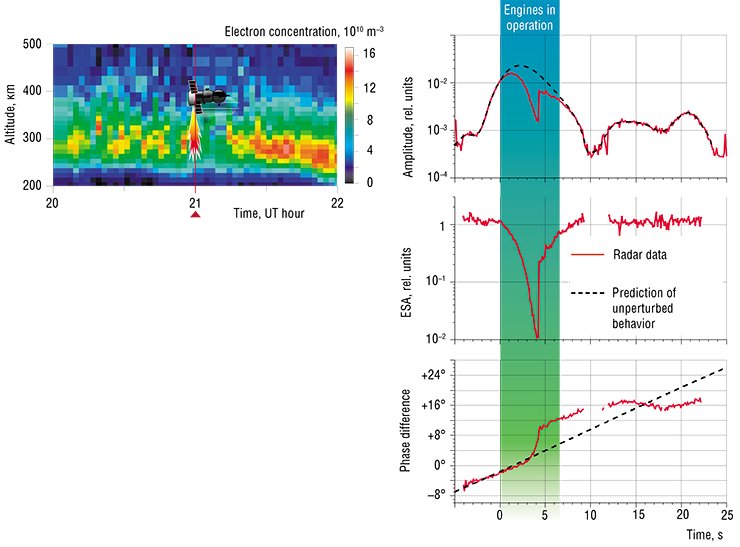
Interest in this subject is caused by the fact that natural plasma is affected by a large number of almost uncontrollable factors. Researchers, in turn, have always been interested in minimizing the uncertainty in the experiment. Now there is a possibility that they will observe the atmosphere response to a known and rigorously dosed action.
After accomplishing its mission at the ISS, the Progress transport vehicle usually has a certain excess amount of fuel onboard. This fuel was used for field experiments in the observation zone of the Irkutsk radar. The vehicle engines are not extremely powerful and can burn no more than 10 kg of fuel per second. The researchers were interested to know whether the radar could detect some changes in the ionospheric plasma due to this minor action and whether the shape of the radio location signal from the vehicle itself changes during engine operation.
On the orbital flight segment, Progress enters the radar observation sector only for a few tens of seconds. Therefore, the experiments were carefully planned: radar operation modes and cyclic actuation of the engines were correlated within fractions of a second.
By 2011, 44 sessions of Progress observations had been performed. First of all, a stable effect of a local (10—20 minutes) decrease in electron concentration by 10—15 % at the vehicle flight altitude was observed. This effect was most clearly manifested if the plume was ejected toward the radar. Therefore, we can definitely say that the radar “notices” the engine operation. There were also significant changes in the “radio image” of the space vehicle itself.
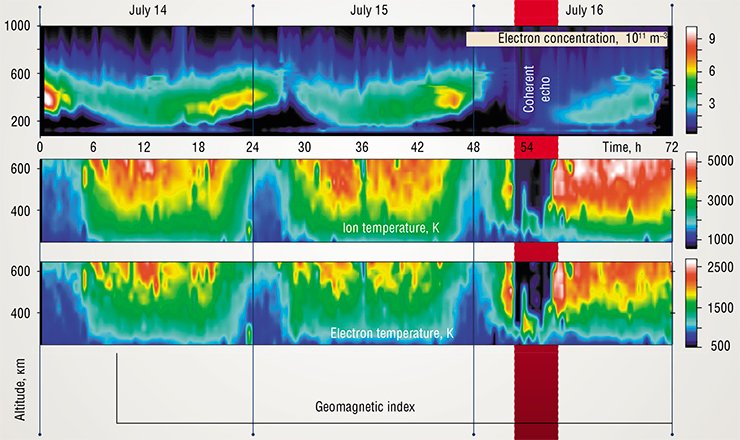
Mathematical modeling has shown that the observed effects can be explained by interference of the signals from two targets, as if an additional reflecting object appeared near the space vehicle. The effective reflection area of this object is at least 10 % of the reflection area of the vehicle. But what is this object: a plasmoid or simply a cloud of ice crystals formed from combustion products? This has to be found in the future.
Thus, the major portion of currently available information about the ionosphere is based on long-time observations of IS radars, which are used to study the near-Earth plasma in the range of altitudes from 100 to 1000 km.
However, the key role in the formation of the structure and ion composition of plasma and in the redistribution of energy inside the gas shell of the Earth belongs to physical and chemical processes in the lower, weakly ionized part of the ionosphere and in the neutral atmosphere. Awareness of this fact at the end of the last century stimulated the development of new methods of radio physical diagnostics of the atmosphere. As a result, the so-called mesospheric-stratospheric-tropospheric radars capable of studying the dynamics of the “near spheres,” i. e. below 100 km, were created in several countries.
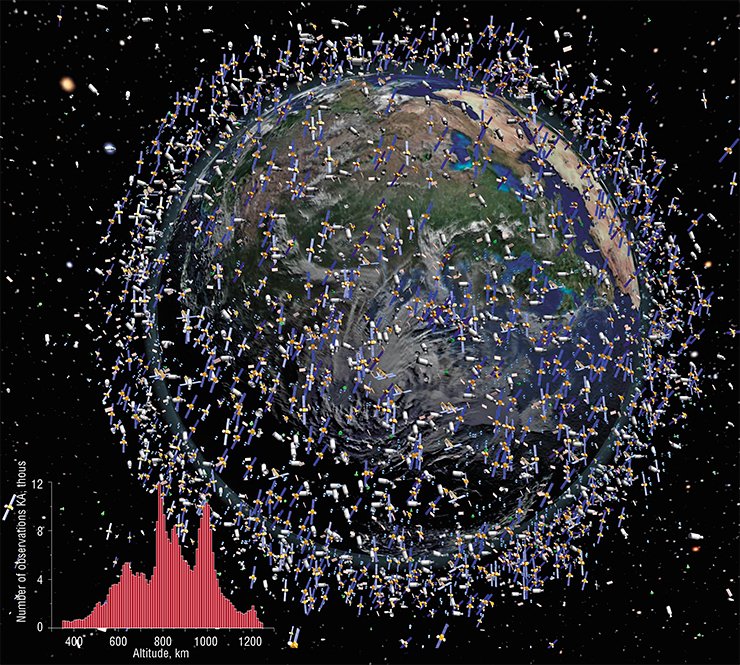
A number of interesting problems resulted from studying the influence of solar activity on atmospheric processes. A new concept of “space weather” is being developed; this concept will cover all aspects of interaction of electromagnetic radiation of the Sun and corpuscular flux of the solar wind with the Earth atmosphere. The Russian government is now considering the project of a national helio-geophysical system which includes constructing a modern IS radar to study mesospheric-stratospheric-tropospheric altitudes.
Worldwide cooperation also includes plans of creating an IS radar in the circumpolar region of Russia. Such a radar placed, for instance, in Norilsk will close the global meridional chain of these high-demand research tools. Participation of Russian scientists in such large-scale international project is not only prestigious, but also necessary to further development of domestic investigations of the near-Earth space and to solve various problems important for the national economy.
References
Zherebcov G. A. i dr. Irkutskij radar nekogerentnogo rassejanija // Radiotehnika i jelektronika, 2002. T. 47. № 11. S. 1339—1345.
Kazimirovskij Je. S. Volshebnoe zerkalo planety. Irkutsk: Vostochno-Sibirskoe knizhnoe izd-vo, 1978. 211 s.
Kazimirovskij Je. S. Planeta v kosmicheskoj plazme. L.: Gidrometeoizdat, 1990. 184 s.
Medvedev A. V. i dr. Metod issledovanija prostran¬stvenno-vremennoj struktury volnovyh vozmushhenij v ionosfere // Geomagnetizm i ajeronomija, 2009. T. 49. № 6. S. 812—823.
Potehin A. P. i dr. Razvitie diagnosticheskih vozmozhnostej Irkutskogo radara nekogerentnogo rassejanija // Kosmicheskie issledovanija. 2008. T. 46. № 4. S. 356—362.
The paper includes photographs taken by V. Korotkoruchko (Irkutsk)
This work was supported by the Ministry of Education and Science of the Russian Federation (State Contract No. 14.740.11.0078).


